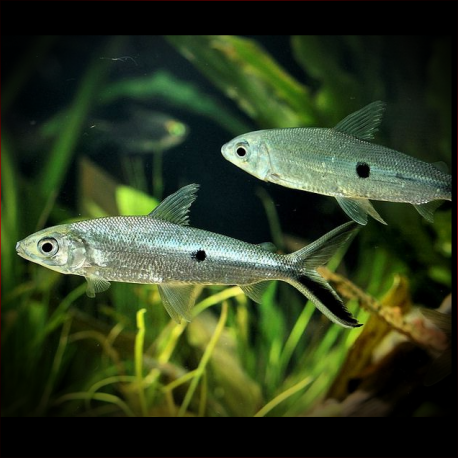More info
Datasheet
| Minimum Tank Size | 255 litres / 67.36 US gallons |
| Maximum Size | 21.5cm / 8.46inches |
| Temperature | 22°C / 71.60°F - 26°C / 78.80°F |
| Hardness | 1-20ºdH |
| pH | 5.5-7.5 |
General Description
Hemiodus Unimaculatus, a member of the Hemiodontidae family, is a peaceful species that can sometimes intimidate smaller or quieter tankmates due to its size and activity. It is best kept in a group in a larger Amazon biotope setup, alongside similarly-sized species like characins, cichlids such as Geophagus and Heros, catfish, and Loricariids. These fish are known to be shoaling by nature and are not commonly found in the hobby due to their skittish nature which fades with time. They are visually similar but can be distinguished by their unique patterning.
Aquarium Setup
For a biotope aquarium suitable for Hemiodus Unimaculatus, an inert sand substrate with smooth rocks, driftwood branches, and twisted roots can be added. Having some floating vegetation helps reduce skittish behavior. The fish thrive in both planted setups and open spaces but requires very well-oxygenated water. Considering their tendency to leap, it is crucial to have a secure tank cover. Regular and strict tank maintenance is vital due to their sensitivity to poor water conditions. (see table)
Behaviour
These fish exhibit peaceful behavior but require a group setting. They prefer to shoal and can coexist with various compatible species in a community tank. Although initially skittish, they become more settled in a group environment. Being a shoaling species, they should always be kept in a group to thrive.
Feeding and Diet
Hemiodus Unimaculatus are not picky eaters and will accept a variety of live, frozen, and dried foods. Including greenery in their diet is important as they heavily feed on plant matter in their natural habitat. Ensuring a balanced diet is essential for their overall health and well-being.
Reproduction & Dimorphism
The breeding behavior of Hemiodus Unimaculatus is not well-documented in captivity. It is presumed to be an egg-scattering species that reproduces during the wet season in their natural habitat. The sexual dimorphism is not clearly defined, but mature females are likely to have a rounder belly compared to males.
Habitat and Distribution
These fish are native to floodplain lakes and fast-moving rivers in Guyana, Suriname, French Guiana, and Brazil. They prefer well-oxygenated waters with a pH range of 5.5-7.5, hardness of 1-20°CdH, and a temperature between 22-26°C. Their natural habitat influences the biotope setup required to provide a suitable environment for them in captivity.

